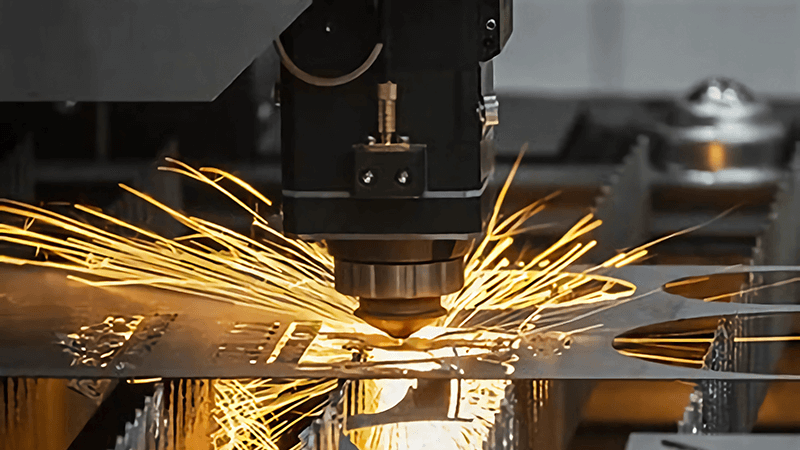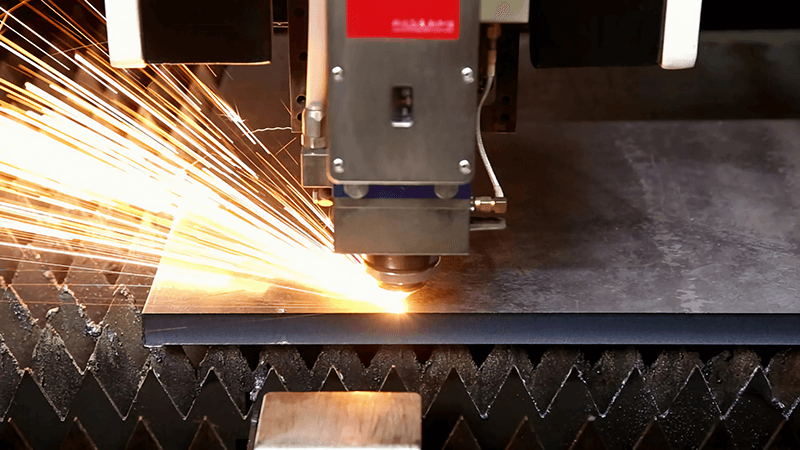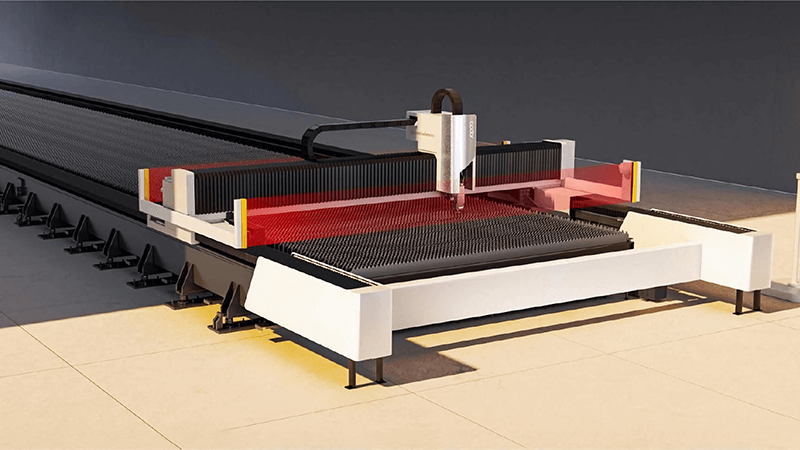If metal cutting were a performance, fiber lasers would be the headline act. They’re fast, precise, and clean—every wholesaler or OEM I talk to wants to know how they work and if they’re worth it.
Fiber laser cutting uses a highly focused beam of light to melt and cut through metal with extreme precision. It's efficient, low-maintenance, and ideal for high-speed industrial work.
For those of us at Kirin Laser, fiber cutting is more than a method—it's a game-changer. Let’s break down how it works, its pros and cons, safety aspects, and how to actually do it.

What is the process of fiber laser cutting?
In manufacturing, speed matters. So does accuracy. Fiber laser cutting delivers both—and that’s why we’ve made it a cornerstone of our machine lineup.
Fiber laser cutting starts with a laser source that sends light through fiber-optic cables. The beam is focused into a tight spot, melts the metal, and a gas blows the molten material away.
How fiber laser cutting works – step by step
From the outside, fiber laser cutting1 might look like magic. But here’s what actually happens under the hood:
1. Laser Generation
The laser source (usually an IPG or Raycus unit in our machines) creates a powerful, focused beam of light in the 1064 nm wavelength. It’s invisible but incredibly intense.
2. Beam Delivery
Instead of bouncing through mirrors like CO₂ lasers, fiber lasers use fiber-optic cables. This makes the system compact, stable, and highly efficient.
3. Focusing
A focusing lens tightens the beam down to a spot just a few microns wide. This is where the real power is—concentrated energy that can cut through 10mm stainless like butter.
4. Cutting Action
The laser melts the metal. A high-pressure assist gas2 (usually nitrogen or oxygen) blasts the molten metal out of the kerf, leaving a clean cut.
| Step | Description |
|---|---|
| Laser Generation | The source emits high-power laser at 1064 nm |
| Beam Delivery | Optical fibers carry the beam to the head, reducing energy loss |
| Focusing | Beam is focused using a lens, creating a tiny, intense heat spot |
| Material Removal | Assist gas expels molten metal, resulting in a clean, narrow cut |
We’ve helped dozens of clients switch to this process, and the results speak for themselves. Clean cuts, faster cycles, minimal waste.

What are the disadvantages of fiber laser cutting?
It’s powerful, yes. But no machine is perfect. Fiber laser cutting has its drawbacks—and as a manufacturer, I’ve heard every complaint and question.
Fiber lasers struggle with reflective materials like copper, have higher upfront costs, and require a learning curve to master settings for each material type.
Let’s unpack the trade-offs
If you’re sourcing machines or considering OEM customization, it’s important to know what you're walking into.
1. Reflective Material Struggles
Fiber lasers can reflect off highly conductive metals like brass or copper. That reflection can damage the laser source, especially without proper protection or wavelength control.
2. Initial Investment
Compared to a basic CO₂ machine, fiber lasers3 are more expensive. That said, the ROI is usually fast. I’ve seen clients break even in six months due to speed and low maintenance.
3. Tuning Takes Time
It’s not just plug-and-play. You need to dial in power, frequency, pulse width, speed, and gas pressure for each type and thickness of metal4. We offer support for that—but it’s still a process.
| Disadvantage | Details |
|---|---|
| Material compatibility | Can be tricky with reflective metals without anti-reflective measures |
| Price | Higher upfront cost than CO₂ or plasma cutters |
| Learning curve | Operators need training to optimize settings for different jobs |
Still, most of our customers agree: the efficiency gains far outweigh these issues.

Is fiber laser cutting safe?
One of the most common questions I get from clients, especially first-timers, is—“Is this safe to run in our facility?” The answer is yes, with proper setup.
Fiber laser cutting is safe when used with enclosed systems, proper shielding, and trained operators. Risks include eye exposure, burns, and fumes—but these are manageable.
Understanding the risks and how we mitigate them
At Kirin Laser, we build safety into every step. Our enclosed machines come with automatic shutoffs, protective lenses, and clear operating instructions.
1. Eye Safety
Laser beams at 1064 nm can damage your retina even from reflections. That’s why all our fiber laser cutting machines(https://kirinlaser.com/why-you-should-invest-in-a-laser-fiber-cutting-machine/)[^5] come with protective housings and windows rated for laser safety.
2. Fume Extraction
Metal vapor and particulates can be harmful if inhaled. Every system we ship includes fume extraction ports, and we recommend a proper exhaust system or air filtration unit.
3. Fire and Burn Risk
It’s a high-heat process—anything flammable nearby can be dangerous. That’s why we always advise clients to clear the workspace and follow routine inspections.
| Safety Concern | Risk Level | Mitigation |
|---|---|---|
| Eye damage | High | Enclosed machine, protective viewing windows, laser goggles (if needed) |
| Toxic fumes | Medium | Built-in fume ports, external extractor recommended |
| Fire hazard | Medium | Metal-only zones, clean workspace, emergency shutoff switch |
Bottom line: If you follow basic protocols and use well-designed equipment, fiber laser cutting5 is one of the safest cutting methods in the industry.

How to do a fiber cut?
Honestly, when I run a fiber laser cutting machine, I treat it like threading a needle—focus the beam, pierce, then sweep it along. Each material needs a different touch.
To perform a fiber laser cut, set up your file in CAD, input it into your machine’s software, calibrate focus, choose the correct power and speed, and start cutting. Always test on a sample first.
Step-by-step for a clean, sharp fiber cut
If you're new, or you're training operators, here’s how I teach it:
1. Prepare the Design
Most of our machines work seamlessly with DXF files. Load the file into the software (we often recommend CypCut6), nest the parts, and set lead-in points.
2. Material Setup
Lay the metal flat on the table. Ensure there’s no rust or oil—these can disrupt the cut. Clamp if needed.
3. Focus Calibration
This is critical. Use auto-focus or manually set the focus height for the thickness you’re cutting. Our machines have capacitive height sensors that keep the nozzle distance constant.
4. Parameter Tuning
Input the correct wattage, speed, duty cycle, frequency, and assist gas. I always do a quick test cut to dial things in—nothing replaces that hands-on feedback.
5. Start Cutting
Once everything is locked in, hit run. Watch the first few seconds carefully. You’ll hear it when the cut is clean—it’s a smooth, steady buzz.
| Step | Tool/Setting Needed | Tips |
|---|---|---|
| File prep | CAD + nesting software | Keep paths efficient, use corner smoothing |
| Focus setup | Auto/manual focus system | Align lens and clean the nozzle |
| Parameter tuning | Wattage, speed, gas type | Start slow and fine-tune upward |
| Cutting | Fiber laser head, motion platform | Listen for smooth cutting sound, watch for sparks |
A client once called me frustrated—he was cutting stainless steel signs with a CO₂ machine and kept burning edges or warping parts. We switched him to a fiber laser cutter7. Within a week, he cut twice as fast, with cleaner edges and zero post-processing. He told me, “It’s like going from a flip phone to a smartphone.” I just smiled—because I knew exactly what he meant.

Conclusion
Fiber laser cutting8 isn’t just another tool—it’s a whole new level of precision and productivity. From how the beam slices clean through stainless steel, to the quiet reliability of each part moving in sync, it’s something I’ve come to trust deeply. At Kirin Laser, we’ve built our machines to bring that performance to every shop, every distributor, and every client who needs speed and quality in one beam.
-
Explore the advantages of fiber laser cutting technology to understand its efficiency and precision in various applications. ↩
-
Learn about the importance of assist gas in laser cutting processes and how it enhances the quality of cuts. ↩
-
Explore this link to understand the full potential and limitations of fiber lasers, helping you make informed decisions. ↩
-
Understanding how metal thickness impacts laser settings can optimize your cutting process, ensuring precision and efficiency in your operations. ↩
-
Discover why fiber laser cutting is considered one of the safest methods with advanced safety features and protocols to ensure user protection. ↩
-
Learn how CypCut software enhances laser cutting processes and improves design efficiency. ↩
-
Explore the advantages of fiber laser cutters for precision and efficiency in metal cutting. ↩
-
Find the best lase cutting machine and laser cutting solutions from Kirin Laser, clicking this link to get all your needs for your applications. ↩





